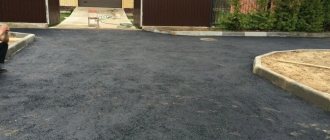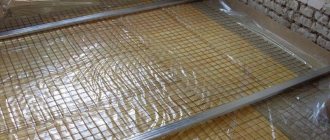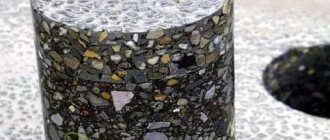Asphalt concrete pavement is a compacted layer of artificial building material consisting of mineral powder, aggregates and bitumen binder. The mixture has valuable properties that are used in laying roads, constructing runways, pedestrian communications, and landscape architecture.
The history of asphalt concrete pavements goes back a long way. The American Incas built magnificent roads from stones, pouring natural bitumen into the joints. The innovation came to Europe much later. Asphalt concrete replaced stone and wooden paving stones. Today it is the most common material for road construction.
The first paved roads
Asphalt pavements were first used in Babylon (around 600 BC). Bitumen to create hard surfaces was extracted from rocks. After the ancient civilization was destroyed, road construction using bitumen materials was resumed only in the 19th century in Western Europe. Then the technology began to be actively used in the USA. In this case, the asphalt coating consisted of bitumen-containing rocks, crushed to a powder state. This type of surface is called “rammed asphalt”.
What kind of asphalt concrete mixture can be, depending on its type
The type of asphalt concrete is determined by its composition and the percentage of the main aggregate. Some types of mixtures can only be hot, and some can only be hot and cold. The higher the type of asphalt mixture, the higher the quality of the material.
| Mixture type | Options |
| A | Hot mixtures containing at least 50-60% rocks. |
| B | Hot and cold mixtures containing at least 40-50% rocks. |
| IN | Hot and cold mixtures containing at least 30-40% rocks. |
| G | Sand obtained by crushing rocks is used. |
| D | Sand obtained by crushing sedimentary rocks is used. |
The appearance of asphalt in Russia
In our country, asphalt began to be produced in 1869 from Syzran asphalt rocks. Unlike foreign compacted asphalt, in the Russian Empire the road surface was made from a molten mixture containing gravel and sand, bitumen and asphalt rock. The finished asphalt was dumped onto the ground and leveled using hand tools. Next, the road was pressed down with a massive load. This technology is referred to by experts as “cast asphalt”. Beginning in 1906, petroleum bitumen began to be added to it.
At the beginning of the 20th century, scientists came up with special asphalt concrete mixtures, which gradually began to replace compacted and cast pavements. The main advantages of the new product were that the work of preparing the coating, applying it and compacting it was carried out in a completely mechanical mode without the use of manual labor. In the USSR, the first section of road made of asphalt concrete pavement appeared on the Volokolamsk Highway in 1928 thanks to the efforts of Professor P.V. Sakharov.
Where is asphalt concrete mixture used?
Due to the fact that the asphalt concrete mixture can have various physical and mechanical characteristics, including very high ones, the range of application of the material is quite wide.
Where is asphalt concrete used:
- Construction of highways;
- Arrangement of pedestrian zones;
- Repair of asphalt pavements;
- Construction of adjacent areas, parking lots, access roads;
- Asphalting of children's and sports grounds;
- Construction of sports facilities;
- Construction of runways;
- Formation of coating in warehouses.
In fact, a suitable asphalt concrete mixture can be used to construct any surface that requires rigidity and hardness.
Advantages of asphalt concrete
Nowadays, of the total length of roads in Russia, more than 60 percent are made of asphalt concrete pavement. This popularity of the material for road construction is explained by its following advantages:
- Slow wear.
- High resistance to loads.
- Resistant to temperature changes and water.
- Easy dismantling and cleaning.
- Possibility to reuse the material.
- Reduced vibration while vehicles are moving on the road.
The work of asphalt concrete pavement is to reduce vibration that is created as a result of the movement of heavy vehicles. This road surface reduces noise from wheels and also promotes smooth and quiet movement of traffic.
The construction of roads from asphalt concrete pavement can be carried out in a flow-high-speed manner using a complex mechanized process.
Asphalt concrete is laid on the road with a slope of no more than 60 percent. For slopes greater than 40 percent, the surface is roughened to ensure sufficient grip on the vehicle's tires. The cross slope of the asphalt should be between 15-20 percent.
Using tar concrete mixture
Much less often, for the construction of asphalt concrete road surfaces, tar and concrete mixtures are used, to which coal tar is added for viscosity. This type of coating is almost no different in appearance from classic asphalt concrete. Tar concrete mixture is more wear-resistant and deteriorates faster from temperature changes and exposure to water. In addition, it is quickly erased under the influence of rubber tires of vehicles.
Tar concrete is prohibited from being used in cities, since the fumes of light fractions of tar are harmful to humans. In addition, under the influence of water, phenols are soaked out of such asphalt, which are harmful to humans and the environment.
Bitumen
Bitumen is a product of oil refining and acts as a binding material in asphalt concrete. No asphalt mixture can function normally without bitumen, since bitumen is the only binding component in the composition. In addition to gluing grains of other materials, adding bitumen also allows you to fill all the voids between the fractions.
The level of bitumen viscosity depends on the specific type of asphalt concrete. As the temperature increases, the viscosity decreases, and as the temperature decreases, it increases. Therefore, hot asphalt mixtures are heated before laying, gaining strength as they cool.
Asphalt composition
Many people are interested in the construction of pavement made from asphalt concrete mixture. The main components of the top layer of the road are bitumen, sand, types of crushed stone and gravel. Fillers and mineral components are also added to some varieties to give the mixture increased strength.
Sand in the asphalt concrete pavement plays the role of a filler, which is necessary for uniform pressure of the mixture on the ground during laying and hardening. Without sand, the road would spread out and gravel would come out. Cement is added to some special compositions, which together with sand gives the coating additional hardness.
Rock crushed to form dust, such as limestone, chalk or sandstone, is used as a mineral filler in the construction of asphalt concrete pavements. It is designed to fill small voids during road laying. Sandstone is the most versatile because it is inert to any chemical. Chalk and lime are usually used on public roads. Sandstone is added during road construction near chemical plants.
Rubber crumbs no larger than 1.5 mm in diameter are added to the asphalt to give the coating elasticity and resistance to water. Asphalt concrete pavement with sufficient addition of rubber in its composition is rarely subject to cracks. However, such material is prohibitively expensive, so its use is often irrational. Typically, rubber filler is added during the construction of high-speed highways.
Rules for laying asphalt concrete pavement
Even if you use high-quality asphalt concrete pavement, but do not follow the technology when laying it, the pavement will quickly fail. The procedure consists of three stages: preparation, arrangement of the pillow and installation itself.
Preparation
First, a technical design is developed and a financial estimate is prepared. When planning an object, it is “tied” to the terrain in order to ensure the removal of wastewater and maintain the location of communications. Before laying the asphalt surface, large trees are cut down and the top layer of soil is removed. The expected load of the roadbed affects the volume of excavation work. The easiest to arrange are garden paths and sidewalks - in these cases it is necessary to remove the top layer of soil 10 to 20 cm thick. If we are talking about a loaded route, it will be necessary to remove up to several meters.
Drainage must be installed under the road to prevent groundwater from lingering. The “removed” soil is transported outside the facility so that it does not cause clogging of the drainage system.
Figure 4. Laying asphalt concrete pavement
Pillow device
The purpose of the pillow is to absorb the loads from vehicle traffic. The thickness of each asphalt pavement is determined during calculations. The first layer is coarse-grained, with particle sizes up to 60 mm. Next is the “middle” layer – 20 – 40 mm. Sand is poured on top. Each layer must be compacted.
If we are talking about creating private coatings, then instead of powder in the form of crushed stone and gravel, they use various construction waste. The edges of the asphalt concrete pavement are covered with curbs.
Figure 5. Vibration cushion under asphalt concrete pavement
Laying
Install the canvases in dry weather, when the temperature is above +5 degrees Celsius. As mentioned above, there are several types of asphalt concrete mixtures, and each has its own laying technologies:
- cold mixture. Laying is carried out on top of the prepared base, into which bitumen up to 5 cm thick is additionally poured. Compacted manually or using a vibrating plate. The top layer is covered with sand or cement, which reduces the stickiness of the new canvas;
- hot mixture. The prepared components are thoroughly mixed and then laid out on the base. The mass is rolled or compacted. It is allowed to use the road 6 hours after laying;
- cast asphalt. Its installation temperature is up to 235 degrees Celsius. The mixture is heated and mixed in special equipment - a koher, from where it is supplied to the hopper of the asphalt paver. The latter distributes it evenly over the asphalt surface. There is no need to compact or roll this type of asphalt. After cooling, the material hardens.
The laying rules are established by the following standards: GOST R 54401-2011, 9128-2009, SNiP 3.06.03-85.
Figure 6. Equipment for laying asphalt concrete pavement
Classification
One of the main parameters in the construction of asphalt concrete pavement is the size of the crushed stone used in its composition. Based on this, the mixture is divided into several groups:
- Dense mixtures. They are used during laying of the top layer of asphalt concrete pavement. This asphalt contains fine-grained crushed stone. During the construction of highways designed for the movement of light vehicles (bicycles and strollers), as well as for pedestrians, crushed stone with a diameter of no more than 5 mm can be used. Larger fractions (up to 15 mm) can be placed on roads for passenger traffic only.
- Porous mixtures are the best option for constructing asphalt concrete pavement where trucks will travel. Typically, it is used for initial installation on soil or gravel. The composition of asphalt differs from dense asphalt in that a small amount of bitumen is added to it.
- Highly porous mixtures are the best option for laying and repairing asphalt concrete pavements on roads with high traffic intensity, especially if heavy, large vehicles travel on the roads. To produce this type of asphalt, large crushed stone (up to 40 mm) is added to the mixture. These dimensions allow for good water permeability. This property is especially important in places where it is necessary to build drainage, for example in swampy areas or in lowlands.
Categories of loads on asphalt pavement
| Load type | Decoding |
| Small | Pedestrian areas only: sidewalks, paths, local areas, courtyards, etc. |
| Small | Personal parking for cars, driveways, garages, parking lots, etc. |
| Average | Roads on which only passenger vehicles will travel |
| High | Roads along which passenger and freight transport will travel |
| Very high | Expressways, federal highways, airfields, etc. |
For areas with low load, you can equip an asphalt pavement with low material consumption, as well as with a composition from the budget category - this will be quite enough. For objects with high and very high loads, it is necessary to use more asphalt concrete with the best characteristics.
Asphalt production
The technology of asphalt concrete pavements consists of preparing raw materials, mixing them and simultaneously heating them to a high temperature, as well as storing the resulting asphalt in a special heated bunker.
When repairing or constructing a road, it is important that the plant is located as close as possible to the laying site, since the construction material must be hot. If the asphalt concrete cools down, it will be difficult to compact it, and the resulting road will quickly become unusable.
What is the difference between asphalt and asphalt concrete?
Many people confuse the concepts of asphalt and asphalt concrete mixture. Despite the similarity of name, there is a difference between them.
What is asphalt? It is of natural origin. Formed during oxidation and thickening of oil. This happens when it comes into contact with outside air. Asphalt deposits can be represented by layers, lakes and individual vein deposits.
Asphalt composition. The word "asphalt" is of ancient Greek origin. It can be translated into Russian as “mountain resin.” The substance is highly flammable. The composition consists of 70% petroleum bitumen.
The largest sources of naturally occurring asphalt are the Dead Sea, located in Israel, and Peach Lake on the island of Trinidad. The Indians extracted asphalt from blocks that floated to the surface of the water, weighing 1 ton.
This material was used for sealing ship hulls, various buildings, and in the production of paint and varnish mixtures.
Types of asphalt. It can be natural or artificial. The supply of natural asphalt is not endless. Now this material is used to create paints for painting, as well as special varnishes. During road construction in asphalt concrete pavement, the liquid part of bitumen is replaced with the solid part. In addition to saving natural resources, this makes it possible to increase the strength of the material.
Preparing the Components
Before asphalt production begins, the prepared material is dried and sifted. Sand, rocks and crushed stone are most often supplied to production in a wet state. The presence of water in the composition threatens to reduce the strength characteristics of the future asphalt, as well as splashing of the bitumen mixture heated to a high temperature when moisture gets on it.
All materials received at the plant are dried at a temperature of 150 degrees. Sifting is carried out using a screen. The mineral filler is crushed in a crusher to a powder state. Depending on the technology, drying can be single or double. Repeated removal of moisture can take place after sifting and crushing.
Mineral powder
Mineral powder is made by grinding limestone, dolomite and other similar materials. This is often made from small residues after crushing the above-mentioned materials during the process of making crushed stone. A high-quality asphalt concrete mixture contains mineral powder, the minimum quality of which is regulated by GOST standards.
As part of asphalt concrete, mineral powder increases strength, durability, stability and elasticity. This ensures not only an increase in performance characteristics, but also an increase in the service life of the coating. It is important to choose the correct proportion of powder, since decreasing or increasing the optimal amount can reduce the physical and mechanical characteristics of asphalt concrete.
The moisture absorption coefficient of mineral powder should not be more than 1.
Mixing processed components
After pre-treatment, crushed stone and sand enter the conveyor, from where they are transported to a bunker and then mixed with bitumen. After this, the temperature in the bunker is raised to 160 degrees and the contents are left heated for storage for up to 4 days. If the material is not shipped to the consumer within this period, it will begin to lose its strength characteristics.
Additives to asphalt and crumb rubber are added to the finished and heated mixture, which gives the material additional strength and resistance to external factors.
Road quality check
Asphalt concrete must comply with established GOSTs and SNiPs adopted in our country. A certificate of compliance with regulatory documents is issued to the manufacturer only after passing comprehensive tests.
There are several laboratories in Russia that monitor the quality of roads. They take samples of the finished asphalt concrete pavement and check it for compliance with various parameters.
During research, an average sample is selected from the total mass of asphalt concrete. Analysis of an already constructed road is carried out by examining a core (the so-called asphalt core). It is obtained by drilling the base of an asphalt concrete pavement using a special hollow drill.
Application of cold asphalt
In those places where delivery of hot building materials for repair or construction of the route is impossible, cold laying of asphalt concrete pavement is used. The technology of such road construction is characterized by lower operating temperatures for heating the mixture (asphalt is heated to 100 degrees). To give the road sufficient strength, polymer compounds are used.
Before laying, workers heat not only the asphalt concrete, but also the site of the planned laying. Depending on the variety, the road can be made even during frosts.
One of the advantages of cold laying is the long shelf life of the road construction material. Unlike conventional asphalt concrete, frost-resistant asphalt can be laid after several weeks. However, this material also has significant disadvantages, namely:
- Strength is 2 times less compared to classic asphalt concrete mixture.
- The material has a high price as a result of the addition of additional protective components to its composition.
- The laying technology is becoming more complicated, which leads to an increase in the cost of the road surface.
- Does not withstand heavy loads. The movement of vehicles weighing over 3.5 tons is prohibited.
A vibrating plate is used to compact cold asphalt, and final laying occurs after a period of time when, during operation, cars move along the finished road, thereby compacting the coating.
Composition and technical characteristics
The composition of asphalt concrete is multicomponent. It is selected and calculated based on the operating conditions of the coating, as well as available local materials.
Components
30-60% of the asphalt concrete mixture consists of crushed stone or gravel, which is obtained during the development of deposits of sedimentary or volcanic rocks, from metallurgical waste. The properties of the coating depend largely on the physical characteristics and shape of this coarse aggregate.
Sand is an essential component of asphalt concrete. It fills the voids between the stones, making the mixture more uniform and dense. The grain content is limited, since excess impairs the wear resistance of the coating. In addition to bulk material of natural origin, screenings from crushed stone or sedimentary rocks and ground slag are used.
Mineral powder makes up up to 20% of the mass of the asphalt concrete mixture. These are sedimentary or dolomite rocks crushed to dust, industrial waste, and ash slag from thermal power plants. They are used in non-activated or activated form. This increases the water resistance, strength and density of asphalt concrete.
The grade of bitumen is selected based on the climatic zone and the standard load on the road surface. The consumption of the petroleum product is 25-90 kg per ton of asphalt concrete mixture and depends on the porosity of the aggregates and the laying mode. To improve its performance properties, bitumen is modified with additives containing crumb rubber, recycled polyethylene, slaked lime and an adhesive composition.
Main technical characteristics
Depending on the properties and raw materials used, GOST distinguishes 3 grades of asphalt concrete:
- I includes hot high-density and dense types A, B, D, porous highly porous crushed stone, cold types Bx, Bx, Gx;
- Ko II - hot B, V, G, D, porous, highly porous sandy, cold Bx, Bx, Gx, Dx;
- to III - hot dense B, G, C, D.
The main physical and mechanical properties of asphalt concrete mixtures are determined by the brand, laying mode and temperature during testing:
- compressive strength - normalized for 0°C - 9-13 MPa, for 20°C - 2-2.5 MPa, 50°C - 0.9-1.5 MPa;
- density - 2000-2800 kg/m³;
- water resistance - 0.6-0.95;
- coefficient of internal friction (shear resistance) - 0.62-0.87;
- shear adhesion at t=50°C - 0.22-0.50 MPa;
- crack resistance - 2-7.5 MPa;
- water saturation - 1-4% for dense, 4-10% for porous;
- porosity for cold asphalt concrete mixtures - 18-21%;
- frost resistance F15-50 depending on the road-climatic zone.
The most important indicator is the compaction coefficient of the asphalt concrete pavement, which characterizes the quality of the laying. It is determined empirically. According to the standards, the value for cold compositions should not be less than 0.96, for hot ones - 0.99.
To measure the compaction coefficient of the mixture, cores are cut out in the pavement, dried, and the actual specific gravity of the asphalt concrete is determined. After heating, the samples are crushed and subjected to pressure treatment. The required parameter is defined as the ratio of the real density to the standard density obtained as a result of tests.
To calculate the consumption of asphalt concrete per 1 m² of pavement, use experimental indicators per 1 cm of height:
- fine-grained mixtures of types A, B, C - 24.6-25.7 kg;
- coarse-grained - 24.2 kg;
- ShMA - 25.8 kg;
- cast with a density of 1500 kg/m³ - 15.4 kg.
How old asphalt is recycled
Processing asphalt concrete to produce a new mixture for road construction is a high-tech process. To produce high-quality coating using the recycling method, you must:
- Cut off the old pavement layer using a remixer. Such equipment carefully removes a given layer of the road using a special cutter.
- Crush the milled layer to the size of crushed stone. The resulting material is called “granulator”. It is used for repairing roads and preparing other building mixtures.
- Heat the furnace to melt the granulator, but do not use open sources of fire, as an explosion may occur.
- Add bitumen and various additives to the oven, if required by the new asphalt production technology.
Technology such as recycling is usually used for the construction of roads in the city. Recycled asphalt has the same properties as new one, but the price is much lower.
What materials are used for paving
There are 3 main types of hot asphalt concrete used as a covering material for highways and pedestrian traffic areas:
- 1. Crushed stone-mastic - the highest quality, suitable for any coating, including high-traffic areas.
- 2. Gravel - has average characteristics, can be used for roads with average traffic, as well as for pedestrian areas.
- 3. Sandy - has relatively low characteristics, but is quite suitable for high-quality construction of pedestrian areas.
Advantages and disadvantages of asphalt
Asphalt concrete pavement has been used for traffic for several decades. There is no replacement for it yet, and here's why:
- Asphalt pavement is not very expensive, especially if the road is designed for light vehicles.
- Asphalt can withstand frost, is not afraid of moisture and heavy rains, of course, if the technology for its installation is followed.
- If the coating is partially destroyed, it can be restored through patching.
- In harsh climates, “cold asphalt” technology can be used.
Asphalt concrete construction
Experts strive to design and build roads in such a way that the road surface has as few layers as possible, down to one. It is advisable that asphalt concrete be laid directly on the ground. The minimum number of layers reduces the time required to repair the road surface, facilitates the organization of the construction of new roads, and reduces the variety of equipment required for laying asphalt.
The modern design of asphalt concrete pavement consists of the following parts:
- Upper layer.
- Bottom porous layer.
- Crushed stone mixed with binders.
- The base is made of gravel or crushed stone.
- Sand layer.
- Crushed asphalt concrete.
During the construction of asphalt concrete pavements, a number of conditions must be observed. For a strong connection between the top layer of asphalt and the base, a crack-resistant material made of bitumen-treated materials with a height of at least 15 cm is applied. The thickness of the asphalt concrete coating, which is laid on a base made of mineral materials, must be at least 5-6 cm.
How can an asphalt concrete mixture be classified by porosity?
In this case, residual porosity is implied. The indicator reflects the density of asphalt concrete after compaction. In this case, porosity may also depend on the quality of the compaction, but for comparison, let’s assume that the compaction was the same.
| Type of mixture by density | Porosity after compaction |
| High density | 1 – 2,5% |
| Dense | 2,5 – 5% |
| Porous | 5 – 10% |
| Highly porous | 10 – 18% |
More porous mixtures are used in the lower layers of asphalt concrete, forming a stabilizing layer, and less porous ones are placed in the upper layers of the pavement, forming a hard layer that prevents wear.











